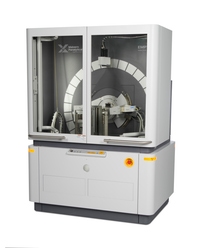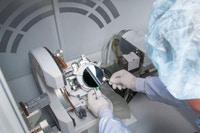Residual stress analysis
Improving safety
Improving safety
X-ray diffraction (XRD) is a well-established, non-destructive method for the determination of residual stress in polycrystalline materials.
Induced by thermal treatment or machining, for example, stress can accumulate during the lifetime of a material and cause unexpected failure of a technical component in a mechanical construction.
The control of residual stress is therefore essential to improve a material’s safety and durability.
Residual stress induces small changes in the crystal lattice spacing of a material, which can be revealed by XRD analysis with a very high sensitivity.
In practice, the position of a suitable diffraction peak is measured in a certain spot under various orientations of the sample relative to the incident X-ray beam. From this the lattice spacings in different directions, and the related elastic strain can be determined.
Tensile stress or compressive stress can then be calculated from the strain data taking into account the elastic constant of the material.
X-ray diffraction (XRD) residual stress analysis can be applied to a wide variety of polycrystalline materials, such as hardened steel, welded joints or ceramics. It is used as a quality control tool as well as in academic and industrial research. Often no special sample preparation is required.
With X-ray diffraction (XRD), it is the near-surface residual stress - typically in a depth of a few microns - which is being probed. Films and coatings with sub-micron thickness can also be investigated by using a grazing incidence geometry. This technique also allows for depth profiling.
It is also possible to map stress across the surface of a material by using an incident X-ray beam with a very small spot size. Additionally, solutions exist for measuring bulky and heavy samples, small curved samples, or uneven sample surfaces.

Empyrean rangeMultipurpose X-ray diffractometers for your analytical needs |

X'Pert³ MRDVersatile research & development XRD system |

X'Pert³ MRD XLVersatile research, development & quality control XRD system |
|
|---|---|---|---|
| Measurement type | |||
| Particle shape | |||
| Particle size | |||
| Crystal structure determination | |||
| Phase identification | |||
| Phase quantification | |||
| Contaminant detection and analysis | |||
| Epitaxy analysis | |||
| Interface roughness | |||
| 3D structure / imaging | |||
| Thin film metrology | |||
| Technology | |||
| X-ray Diffraction (XRD) | |||